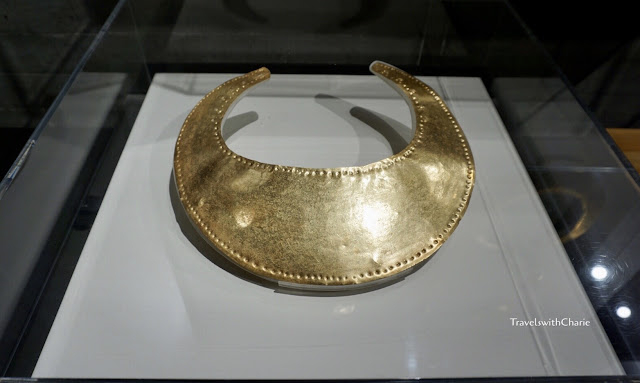Semi circular chest plate, gold, 700 A.D., South Pacific
The Pre-Colombian Gold Museum is one of three museums created in the 1950s by the Central Bank of Costa Rica from the original History and Numismatic Museum to promote “meaningful and relevant connections with the material and human dimensions” of Costa Rican cultural heritage. The museum is in an underground vault in the center of San Jose.
How gold jewelry was worn by the indigenous people of Costa Rica
1. Semi circular convex chest plate
2. Round zoomorphic and geometrical chest plate from 700 - 1500A.D., hammered
gold with four cones protruding from the plate, worn by high ranking individuals,
South Pacific
3. Pendants
4. Plain round chest plate
Collar and buckle with embossed decoration
Crab rattle, 700 A.D. to 1559 A.D., South Pacific
Anthropo-zoomorphic pendant
The use of animal or avimorphic pendants has a symbolic meaning to the wearer. These pendants may represent the cosmos or the spirit world or to intimidate the enemy.Anthropo-avimorphic pendant, gold, South Pacific
Male figure wearing a saurian costume and bird mask with beak. Two snake heads project from his belt.
Indigenous women played an important role in their communities. They were caciques (tribal chiefs), curanderas (healers) and warriors.
Ceramic pottery, 800 A.D. to 1500 A.D.
The center pot has the head of an armadillo and is elaboratedly painted in black, red and cream. Notice the arms and feet with painted toenails. These pieces depicting animal and bird designs are consistent with those found on metal objects of the period (as shown in the images above).Stone metate with animal head
A metate is used for grinding/crushing maize or grain with a small stone. Some metates in the museum date back to 700 A.D. How to get there:
The Gold Museum is in the center of the city of San Jose, behind the National Theater and under the Plaza de de La Cultura. Please check the museum website for current entrance fee. Big bags or backpacks are not allowed in the museum. You’ll have to leave this in a locker. Covid-19 safety precautions are observed.
*****
Images by TravelswithCharie











